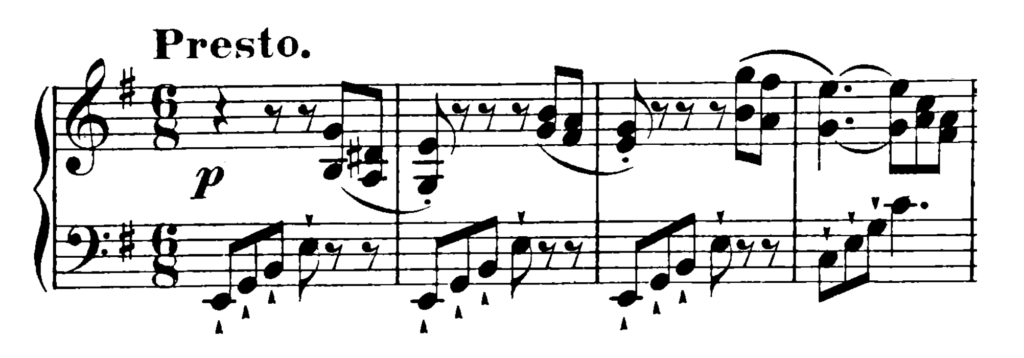Analysis
Contents
First Movement (Allegro)
Form: Sonata Form. E Minor.
EXPOSITION (Bars 1-45):
Bars 1-8: First Subject. Tonic key, E minor, ends with Imperfect Cadence.
Bars 9-29: Bridge Passage or Episode. Built upon Material of First Subject, commencing in E minor, passing through A minor (Bar 11), G Major (Bar 13), D Major (Bar 25), to end with Perfect Cadence (Bar 29).
Bars 30-45: Second Subject. Relative Major key, G Major; touches A minor (Bar 32) and again at Bar 38. Perfect Cadence (Bars 41-45).
Bars 42-45: Coda. Tonic Chord.
Double Bar and Repeat.
DEVELOPMENT (Bars 46-78):
Commences with Material of First Subject in Tonic Major, E Major, moving to C Major (Bar 51), then a Series of chords of the Seventh (Bars 54-63) leads to Dominant key, B minor (Bar 64). Material of First Subject in an Inverted Form appears in G Major (Bar 71), C Major (Bar 75), to end the Development with Imperfect Cadence in Tonic key, E minor (Bar 78).
RECAPITULATION (Bars 79-127):
Bars 79-86: First Subject. Tonic key, E minor, ends with Imperfect Cadence.
Bars 86-94: Bridge Passage or Episode. The opening 13 Bars of Episode or Exposition are now omitted and the eight bars used here are altered to lead to Tonic key, E minor.
Bars 95-124: Second Subject. Tonic key, E minor, moves to C Major (Bar 111), A minor (Bar 114), returns to E minor (Bar 116).
Bars 124-127: Coda. Material of First Subject. Perfect Cadence in E minor.
Second Movement (Adagio)
Form: Ternary Form. G Major.
PART I (Bars 1-20):
Tonic key, G Major, modulates to Dominant key, D Major (Bar 13), ends with Perfect Cadence and Suspended Leading Note (Bar 20).
Double Bar and Repeat.
PART II (Bar 21-31):
Commences with Material of Part I in Relative minor key, E minor, an arpeggio passage enters in A minor (Bar 25), G Major (Bar 27), D Major (Bar 29), ends with Perfect Cadence and Suspended Leading Note (Bar 31).
PART III (Bar 32-49):
Return of Part I in Tonic key, G Major, ending with Interrupted Cadence in G Major (Bars 44-45), Sub-mediant chord of G Major becoming the Tonic Chord of E minor. Bars 45-49 consist of Dominant Harmony of E minor to lead, at once, to Third Movement.
Third Movement (Molto Vivace)
Form: Rondo Form. E Minor.
Principle Theme (Bars 1-29):
Principle Theme consists of two main sections:
Bars 1-9: A. Ends with Perfect Cadence in G Major. Double bar and Repeat.
Bars 10-20: B. Begins G Major, moves to E minor (Bar 14), ends with Perfect Cadence in E minor. Double Bar and Repeat.
This is followed by a passage (Bar 21) built upon Material of Principle Theme in Tonic Major key, E Major, moving to its Relative Minor key, C sharp minor (Bar 26), to end with Perfect Cadence in B Major. Double Bar and Repeat.
EPISODE 1 (Bars 30-44):
Commences in E Major, modulates to B Major (Bar 35), returns to E Major (Bar 36), to end with Perfect Cadence (Bars 43-44).
Double Bar and Repeat.
Principle Theme (Bars 45-81):
In Tonic key, E minor. At Bar 64, the second Section is elaborated and moves to Relative Major key, G Major (Bar 67), returning to Material of Principle Theme, slightly altered (Bar 74), Tonic key, E minor. Perfect Cadence.
Double Bar and Repeat.
EPISODE 2 (Bars 82-107):
Complete Ternary Form, A (Bar 82), B (Bar 91), A (Bar 100). Material of First Subject in E Major used with examples of Inversion. Tonic Major moves to Dominant Major, B Major (Bar 87) with Perfect Cadence (Bars 89-90).
Double Bar and Repeat.
E Major (Bar 91) to end Section B, with Perfect Cadence in B Major (Bars 98-99), E Major (Bar 100), to end with Perfect Cadence (Bars 106-107).
Double Bar and Repeat.
Principle Theme (Bars 108-144):
Bars 108-135: Commences in Tonic key, E minor, moves to G Major (Bar 114) and Theme in tonic key is varied at Bar 117, moving again to G Major (Bar 122) and back to E minor (Bar 128).
Bars 135-144: Coda. Ends with Perfect Cadence in Tonic key, E minor









